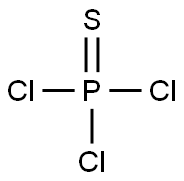티오포스포릴 염화물
|
|
티오포스포릴 염화물 속성
- 녹는점
- -35 °C (lit.)
- 끓는 점
- 125 °C (lit.)
- 밀도
- 1.668 g/mL at 25 °C (lit.)
- 증기압
- 21.9hPa at 25℃
- 굴절률
- n
20/D 1.555(lit.)
- 용해도
- 벤젠: 용해될 수 있다(lit.)
- 물리적 상태
- 액체
- 색상
- 무색의
- Specific Gravity
- 1.668
- 수용성
- H2O에서 가수분해되어 H3PO4, HCl, H2S를 형성합니다. 알칼리성 용액에서 빠르게 가수분해됩니다. 수용성 벤젠, CCl4, CS2, 클로로포름 [MER06]
- 감도
- moisture sensitive
- Merck
- 14,7356
- Dielectric constant
- 2.5(25℃)
- 안정성
- 수분에 민감한
- CAS 데이터베이스
- 3982-91-0(CAS DataBase Reference)
안전
- 위험 및 안전 성명
- 위험 및 사전주의 사항 (GHS)
| 위험품 표기 | T+ | ||
|---|---|---|---|
| 위험 카페고리 넘버 | 22-26-34-52/53 | ||
| 안전지침서 | 26-28-36/37/39-45-61 | ||
| 유엔번호(UN No.) | UN 1837 8/PG 2 | ||
| WGK 독일 | 2 | ||
| RTECS 번호 | XN2930000 | ||
| F 고인화성물질 | 21 | ||
| 위험 등급 | 8 | ||
| 포장분류 | II | ||
| HS 번호 | 28273985 | ||
| 유해 물질 데이터 | 3982-91-0(Hazardous Substances Data) | ||
| 기존화학 물질 | KE-33800 |
| 그림문자(GHS): |
 
|
|||||||||||||||||||||||||||||||||||
|---|---|---|---|---|---|---|---|---|---|---|---|---|---|---|---|---|---|---|---|---|---|---|---|---|---|---|---|---|---|---|---|---|---|---|---|---|
| 신호 어: | Danger | |||||||||||||||||||||||||||||||||||
| 유해·위험 문구: |
|
|||||||||||||||||||||||||||||||||||
| 예방조치문구: |
|
티오포스포릴 염화물 C화학적 특성, 용도, 생산
화학적 성질
clear colourless to slightly yellowish liquid용도
Thiophosphoryl chloride was used in the synthesis of O-ethyl dichlorothiophosphate.일반 설명
A colorless fuming liquid. Boiling point 257°F (125 °C). Irritates the eyes and mucous membranes. Corrosive to metals and tissue.공기와 물의 반응
Fumes in air. Decomposes in water to form phosphoric acid and hydrochloric acid (hydrogen chloride). Both substances are corrosive to metal or tissue. Can also form hydrogen sulfide (H2S), a toxic flammable gas, in reaction with water [AAR 1991].반응 프로필
THIOPHOSPHORYL CHLORIDE is acidic. Incompatible with bases (including amines), with strong oxidizing agents, and with alcohols. May react vigorously or explosively if mixed with diisopropyl ether or other ethers in the presence of trace amounts of metal salts [J. Haz. Mat., 1981, 4, 291].위험도
Strong irritant to skin and tissue.건강위험
TOXIC; inhalation, ingestion or contact (skin, eyes) with vapors, dusts or substance may cause severe injury, burns or death. Reaction with water or moist air will release toxic, corrosive or flammable gases. Reaction with water may generate much heat that will increase the concentration of fumes in the air. Fire will produce irritating, corrosive and/or toxic gases. Runoff from fire control or dilution water may be corrosive and/or toxic and cause pollution.화재위험
Non-combustible, substance itself does not burn but may decompose upon heating to produce corrosive and/or toxic fumes. Vapors may accumulate in confined areas (basement, tanks, hopper/tank cars etc.). Substance will react with water (some violently), releasing corrosive and/or toxic gases and runoff. Contact with metals may evolve flammable hydrogen gas. Containers may explode when heated or if contaminated with water.Safety Profile
Poison by inhalation. Moderately toxic by ingestion. A corrosive irritant to skin, eyes, and mucous membranes. Explosive reaction with methylmagnesium iodlde. Explosive reaction with pentaerythritol + heat. Reacts with water or steam to produce toxic and corrosive fumes. When heated to decomposition it emits highly toxic fumes of POx, SOx, and Cl-.Purification Methods
Possible impurities are PCl5, H3PO4, HCl and AlCl3. Gently mix it with H2O to avoid a heavy emulsion; the product decoulorises immediately and settles to the bottom layer. It is soluble in *C6H6 and CCl4. [Duval Inorg Synth IV 73 1953.] HARMFUL VAPOURS.티오포스포릴 염화물 준비 용품 및 원자재
원자재
준비 용품
디메틸티오린산클로라이드
Phosphorus-containing intermediates of asymmetric organophosphorus pesticides
폭심
Isocarbophos
피리다이펜티온
포노포스
포스티아제이트
(O,O-di-4-chlorophenyl)thiophosphenyl chloride
메틸 파라싸이온(메틸 파라티온)
메타미도포스
피카클로포스
propyl dichlorodithiophosphate
O, O-dialkyl sulphide (alcohol) phosphate
디옥사벤조포스
포스아세팀
O-methyl dichlorothiophosphate
설프로포스
DIMETHYLPHOSPHINOTHIOIC CHLORIDE
페니트로티온
이소펜포스
데미톤
O,O-dialkyl thiophosphoryl chloride
이피엔
프로페탐포스
디에틸 티오포스포릴 염화물
퍼퓨릴 알코올
Isocarbophos E.C.
O,O-Di(4-bromophenyl)thiophosphoryl chloride
프로페노포스
퀴날포스
ETHYL DICHLOROTHIOPHOSPHATE
티오포스포릴 염화물 관련 검색:
모노클로로트라이메틸실레인 비스(트라이뷰틸주석) 옥사이드 트라이뷰틸포스핀 디에틸 티오포스포릴 염화물 디메틸티오린산클로라이드 삼염화 인 티오포스포릴 염화물
Sodium acetate trihydrate
Sodium triacetoxyborohydride
Trimethylsilylacetylene
Trimethylsilyl trifluoromethanesulfonate
Pyridinium tribromide
Potassium trifluoromethanesulfonate
Iodotrimethylsilane
CHLORTHION
BIS(DIMETHYLAMINO)THIOPHOSPHORYL CHLORIDE






